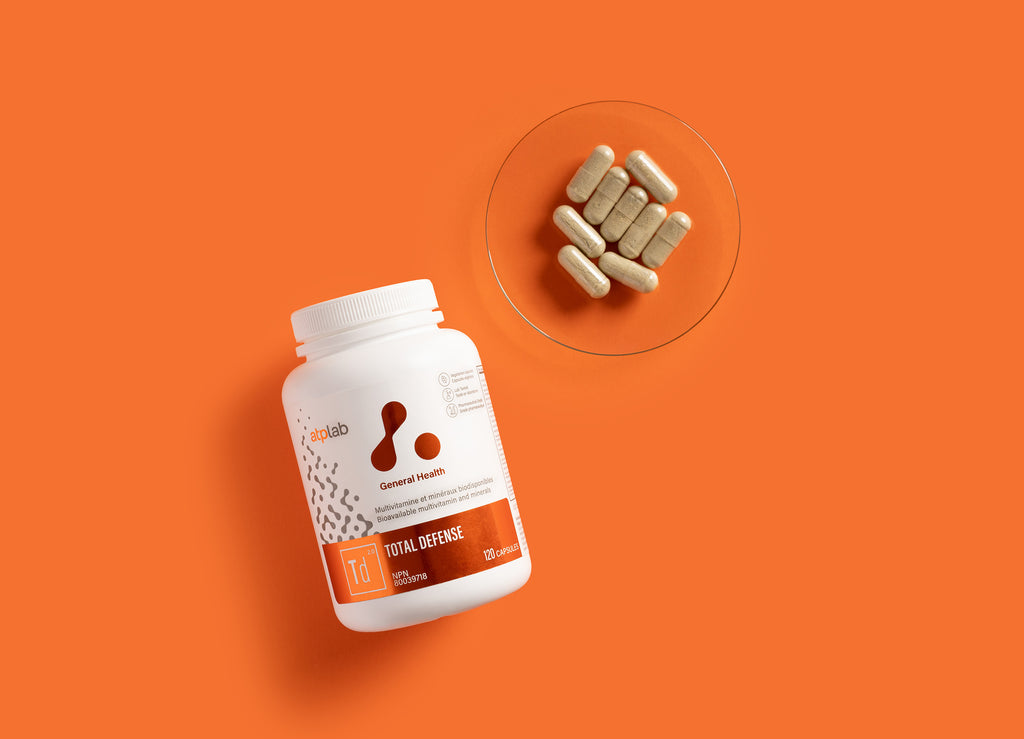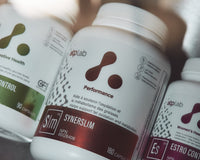Build Your Foundational Supplement Stack

Written by Dwayne N. Jackson, PhD
Nutritional supplements are not the cure for an unhealthy diet and lifestyle. Instead, these supplements are formulated to fill in the common inadequacies in your diet to synergize with your healthy lifestyle.
So, despite the fact that we cannot “outrun” an unhealthy lifestyle with supplements, it’s equally true that most everyone, healthy or not, can benefit from these 5 key supplements.
The foundational 5:
- Total Defense: Active form multivitamin
- Vitamin D3: Bioavailable vitamin D
- SynerMag: Pharmaceutical-grade magnesium formulation
- SynerZinc: Pharmaceutical-grade zinc formulation
- Omega 3 Triglyceride: High potency pharmaceutical-grade Omega-3
As you can see, the first 4 of our 5 recommendations are micronutrients.
Micronutrients (e.g., vitamins and minerals) are essential to normal cellular function and nutrient absorption. As well, they support growth and development of various tissues in the body including bones and muscle.
Meeting daily micronutrient requirements starts with maintaining a healthy balanced diet, consisting of an adequate balance of animal proteins, seeds and nuts, and a variety of fruits and vegetables.
Micronutrient deficiencies are prevalent worldwide
However, such deficiencies don’t only exist in countries where food supply is inadequate. In fact, the data illustrate that many North Americans are susceptible to micronutrient deficiencies, despite the fact that most have relatively high daily caloric intakes.
Micronutrient deficiencies are becoming more common due to:
- Commercial farming that dilutes the micronutrient content of our fruits and vegetables: Our current farming focus on breeding crops that provide greater yield, pest resistance and climate adaptability. Although this has enabled our crops to grow bigger and more rapidly, their ability to uptake and produce nutrients has cannot kept pace with their rapid growth. This has resulted in nutrient dilution throughout the food supply chain.
- Diets that promote micronutrient deficiency: Many people follow diets that restrict calories and limit animal or plant-based nutrition. In these cases, to avoid micronutrient deficiencies, vitamin and mineral supplementation is necessary. Furthermore, many people’s diets are made up of ultra-processed foods, fast food, and/or junk food that tend to be high in caloric value, but low in micronutrient density, contributing to micronutrient deficiencies.
Imbalanced supply and demand: During heavy training metabolic rate goes up and we sweat. These exercise responses increase fat and water soluble vitamin requirements. For those with higher levels of lean mass and elevated metabolism, vitamin needs increase. In many cases, training hard while dieting promotes imbalances in micronutrient supply and demand, this drives chronic micronutrient inadequacies in many.
MICRO-MANAGEMENT
ATP LAB’S Total Defense: Active form Multivitamin with Bioavailable Minerals
When it comes to vitamins, the active forms are the most bioavailable and biologically functional. Being a pharmaceutical-grade multivitamin and mineral supplement, ATP Lab’s Total Defense contains a complete array of patented active form vitamins and chelated minerals, delivering the highest potency micronutrients efficiently, effectively, and at clinically relevant dosing.
How to use Total Defense: If you are concerned with your vitamin and mineral status, we suggest taking 2 capsules of Total Defense 3 times per day, with meals. If you eat a balanced diet and just feel the need to “top up” your vitamins, we still have you covered with TOTAL DEFENSE, as you can take one or two capsules per day to assure you always have all the micronutrients on board that you need.
ATP LAB’s Vitamin D3 spray
Generally less than 20% of the body’s vitamin D needs come from the diet; however, during sun exposure we top off our vitamin D from the conversion of 7-dehydrocholesterol in the skin. Notably, many people limit exposure to the sun’s damaging UV radiation and tend to be vitamin D deficient, especially during winter months in cold climates.
Beyond being essential for calcium metabolism/absorption, adequate vitamin D status plays a pivotal role in the regulation of immune responses, muscle function, muscle recovery, and muscular remodeling in young and older populations. As well, keeping Vitamin D levels topped up improves hormonal/sexual health, including increasing total and free testosterone and sperm quality in men.
How to use Vitamin D3 spray: ATP Lab’s oral vitamin D3 spray is a highly bioavailable pharma-grade Vitamin D3 supplement. We recommend taking 2000 – 5000iu or 4-10 sprays per day in the summer months and 5000-10,000 iu per day in the winter months. You can split doses up and take them before meals, or take it all at once any time of the day.
MINERAL-MANAGEMENT
Whether you are taking a multivitamin like Total Defense or not, the research reminds us that we can all use more Zinc and Magnesium.
Zinc and Magnesium deficiencies are relatively common among North Americans.
Here’s two reasons why:
- The typical North American diet is deficient in these minerals, due to poor food choices, mass farming, and the mineral depleted soil that we grow our vegetables in.
- We are not absorbing minerals efficiently. We live in a time where cases of chronic systemic and gastrointestinal inflammation, celiac disease, prescription drug use (antiacids, antibiotics, birth control pills, etc) and heavy alcohol consumption are on the rise---all of which significantly blunt zinc and magnesium absorption.
Zinc is a nutritionally essential trace element that you must get it from your diet. For meat eaters, It is found in abundance in oysters and in lower concentrations in red meat and chicken. For vegietarians and vegans, much of their zinc is supplied in grains, seeds and nuts, but the phytates present in many of these sources limit absorption.
The World Health Organization (WHO) estimates that nearly two billion people in the developing world may be zinc deficient. This is a serious problem, since zinc deficiency has been shown to impair cellular repair, blunt testicular function, decrease male fertility and sperm quality, and promote decreased immunity, increased oxidative stress, and increased generation of inflammatory cytokines.
ATP LAB’s SynerZinc to the rescue!
SynerZinc is formulated strategically with copper, selenium, and biotin. An ongoing study tracking the nutritional intake of Americans reports that 75% of adult American’s fail to reach adequate dietary levels of zinc, and none of them meet the minimum recommended intake for copper.
Zinc and copper are so similar in their atomic structure that they compete with one another for absorption and utilization in the body's biochemical pathways. When zinc intake is too high relative to copper intake, the excess zinc interferes with the activity of enzymes, which depend on copper to carry out their biological roles.
Too much zinc, without balancing copper intake, can lead to functional copper deficiency by competing for absorption and interfering with its absorption and metabolism. In fact, research suggests that an excessive ratio of zinc to copper has a negative impact on cardiovascular and skeletal health.
ATP LAB’s SynerZinc is an advanced pharma-grade zinc supplement, with 20 mg of patented L-OPTIZINC (Zinc mono-L-methionine) and 15 mg of Zinc glycinate, two of the most bioavailable forms of zinc.
SynerZinc is scientifically balanced with co-factors like copper, selenium, and biotin ensuring the highest bioavailability.
SynerZinc’s unique formulation is balanced with 3 mg of copper with additional support from 50 mcg of selenium, and 100 mcg of biotin.
How to use SynerZinc: To ensure you have enough zinc on board, we recommend taking 1-2 capsules per day, 1 mid-morning (between meals) and 1 before bed.
What about magnesium?
Magnesium is the fourth most abundant mineral found in the body and is vital for proper nerve and muscle function. It is known to help keep the heart beating regularly, it maintains bone health, and supports the immune system.
Magnesium is tightly involved in regulating blood glucose levels and protein synthesis. Magnesium also plays a critical role in the production and bioavailability of ATP. It activates almost all the enzymes in glycolysis and Krebs cycle, which transform our macros (like fats and carbs) into ATP, our cellular energy source. Without magnesium, ATP is destabilized and degraded to adenosine diphosphate (ADP) and inorganic phosphate, which provide no direct energy for cellular function. Research shows that our magnesium needs increase with age, prescription drug use (anti-acids, oral contraception, etc), heavy training, and alcohol consumption. Thus, many people worldwide are deficient in magnesium.
Keeping magnesium levels topped up has been shown to improve symptoms of hypertension & cardiovascular disease, diabetes, depression, asthma, chronic pain, and osteoporosis.
ATP LAB’s SynerMag to the rescue!
SynerMag from ATP lab is formulated using 2 of the most highly bioavailable forms of magnesium:
- Magnesium malate (250 mg), which is magnesium bound to malic acid. Malic Acid has an important role in the generation of mitochondrial ATP (cellular energy) under aerobic and anaerobic conditions. This form of magnesium was included to target the mitochondria and promote increased cellular energy production.
- Magnesium bisglycinate (250 mg), which is magnesium bound to glycine, which is used to increase absorption in the digestive tract to improve gut health and immunity, promote relaxation, and reduce inflammation.
SynerMag is fortified with Taurine (200 mg) and active form Vitamin B6 (5mg).
Magnesium and taurine (an amino acid) synergize to help normalize blood pressure, reduce hyper-excitability of nerves, and improve cardiovascular performance. Low levels of vitamin B6 have been shown to deplete both magnesium and taurine, which is why we included the potent and active form of vitamin B6 (5 mg) called pyridoxyl-5’-phosphate (P-5-P). P-5-P is approximately 5x more absorbable than typical vitamin B6 and this form of Vitamin B6 increases cellular magnesium absorption, the site where magnesium it performs its vital actions.
How to use SynerMag: To ensure your magnesium levels are always topped off, we suggest taking up to 2 capsules of SynerMag (yielding 200 mg of elemental magnesium), twice daily around lunch and dinner time. *Note, too much magnesium can give you stomach cramps and diarrhea. So, when starting out, use a low dose and work up based on tolerance.
Rounding out the Foundational 5 is Omega-3 fish oil. When it comes to controlling inflammation and blood lipids, there’s nothing fishy about daily Omega-3 poly unsaturated fatty acids
Pharmaceutical grade fish oil is loaded with the omega 3 polyunsaturated fatty acids (PUFAs), docosahexaenoic acid (DHA) and eicosapentaenoic acid (EPA). Research claims many health benefits associated with omega 3 fish oil supplementation are mostly due to the positive impact of DHA and EPA on oxidative stress, inflammation, and blood lipid profile. Thus, omega 3 supplementation has been reported to support fat loss, muscle recovery and performance, cardiovascular health, reduced cognitive decline, and the improvement of symptoms of arthritis, inflammatory bowel disease, and asthma.
ATP Lab’s Omega 3 Triglyceride
ATP Lab’s premium fish oil supplements have the highest potency and are never rancid! In fact, we take every precaution to assure you are getting the highest potency, purity, freshness, and efficacy your money can buy.
How do we do this?
- First, for all of our omega-3supplements, we use only the highest quality fresh Anchovy, Sardines, and Mackerel, sourced responsibly from Europe and South Africa. This first step assures that our starting materials are the highest quality, potency and freshness.
- All of our fish oils undergo molecular distillation steps which effectively remove heavy metals, PCBs, dioxins and other contaminants. These steps also serve to concentrate DHA and EPA in the final product; this is why our omega-3products have the highest purity and potency available.
- Our fish oils are protected from oxidation. In our liquid Omega-3triglyceride, we have recently taken significant steps to assure every teaspoon is 100% pure and fresh---this includes limiting the volume of the container to 200 ml and adding the industry’s most potent antioxidant blend (Astaguard SG) to our formulation.
- Like all of our premium supplements, all of the fish oil omega-3products from ATP Lab are 3rd party tested for purity, freshness, and potency. This assures that you get exactly what’s on the label, consistent from batch to batch, and without contaminants or rancid by-products.
How to use ATP LAB’s Omega 3 Triglyceride: Each teaspoon (5 ml) of our ultra-potent Omega-3 triglyceride delivers over 3 g of DHA/EPA. Adults use 1-2 teaspoons per day with food and children (under 18) 1/2 teaspoon (2.5 ml) once per day with food.
References:
Fulgoni VL, 3rd, Keast DR, Bailey RL, Dwyer J. Foods, fortificants, and supplements: Where do Americans get their nutrients? J Nutr. 2011;141(10):1847-1854.
Wallace TC, McBurney M, Fulgoni VL, 3rd. Multivitamin/mineral supplement contribution to micronutrient intakes in the United States, 2007-2010. J Am Coll Nutr. 2014;33(2):94-102.
Wakeel, Abdul and Farooq, Muhammad and Bashir, Khurram and Öztürk, Levent (2018) Micronutrient malnutrition and biofortification: recent advances and future perspectives. In: Hossain, Mohammad Anwar and Kamiya, Takehiro and Burritt, David J. and Tran, Lam-Son Phan and Fujiwara, Toru, (eds.) Plant Micronutrient Use Efficiency: Molecular and Genomic Perspectives in Crop Plants. Elsevier, UK, USA, pp. 225-243. ISBN 978-0-12-812104-7
Ames BN. Low micronutrient intake may accelerate the degenerative diseases of aging through allocation of scarce micronutrients by triage. Proc Natl Acad Sci U S A. 2006;103(47):17589-17594
Yokoi K, Konomi A. Iron deficiency without anaemia is a potential cause of fatigue: meta-analyses of randomised controlled trials and cross-sectional studies. Br J Nutr. 2017;117(10):1422-1431
Huskisson E, Maggini S, Ruf M. The role of vitamins and minerals in energy metabolism and well-being. J Int Med Res. 2007;35(3):277-289
Fairfield KM, Fletcher RH. Vitamins for chronic disease prevention in adults: scientific review. JAMA. 2002;287(23):3116-3126.
Dong JY, Xun P, He K, Qin LQ. Magnesium intake and risk of type 2 diabetes: meta-analysis of prospective cohort studies. Diabetes Care. 2011;34(9):2116-2122.
Wallace TC, McBurney M, Fulgoni VL, 3rd. Multivitamin/mineral supplement contribution to micronutrient intakes in the United States, 2007-2010. J Am Coll Nutr. 2014;33(2):94-102.
Fulgoni VL, 3rd, Keast DR, Bailey RL, Dwyer J. Foods, fortificants, and supplements: Where do Americans get their nutrients? J Nutr. 2011;141(10):1847-1854.
Weaver CM. Calcium. In: Erdman Jr. JW, Macdonald IA, Zeisel SH, eds. Present Knowledge in Nutrition. 10th ed. Ames: Wiley-Blackwell; 2012:434-446.
Angelo G, Drake VJ, Frei B. Efficacy of multivitamin/mineral supplementation to reduce chronic disease risk: a critical review of the evidence from observational studies and randomized controlled trials. Crit Rev Food Sci Nutr. 2015;55(14):1968-1991
Angeline ME, Gee AO, Shindle M, Warren RF, Rodeo SA. The effects of vitamin D deficiency in athletes. Am J Sports Med. 2013 Feb;41(2):461-4.
McClung JP, Gaffney-Stomberg E,, Lee JJ Female athletes: a population at risk of vitamin and mineral deficiencies affecting health and performance. J Trace Elem Med Biol. 2014 Oct;28(4):388-92.
Langlois K, Greene-Finestone L, Little J, Hidiroglou N, Whiting S. Vitamin D Status of Canadians as Measured in the 2007 to 2009 Canadian Health Measures Survey. Health Reports, 2010 March; Catalogue no. 82-003-X. Health Canada, Statistics Canada. Canadian Community Health Survey, Cycle 2.2, Nutrition (2004) - Nutrient Intakes From Food: Provincial, Regional and National Data Tables Volumes 1, 2 & 3 Disk. 2009. Ottawa, Health Canada Publications.
Kim YN, Choi JY, Cho YO. Regular moderate exercise training can alter the urinary excretion of thiamin and riboflavin. Nutr Res Pract. 2015 Feb;9(1):43-8.
Williams MH. Dietary supplements and sports performance: introduction and vitamins. J Int Soc Sports Nutr. 2004 Dec 31;1:1-6.
Woolf K, Manore MM. B-vitamins and exercise: does exercise alter requirements? Int J Sport Nutr Exerc Metab. 2006 Oct;16(5):453-84.
Cinar V, Baltaci AK, Mogulkoc R, Kilic M. Testosterone levels in athletes at rest and exhaustion: effects of calcium supplementation. Biol Trace Elem Res. 2009 Summer;129(1-3):65-9. Epub 2008 Dec 20.
Smyth PP, Duntas LH. Iodine uptake and loss-can frequent strenuous exercise induce iodine deficiency? Horm Metab Res. 2005 Sep;37(9):555-8.
Naziroğlu M, Kilinç F, Uğuz AC, Celik O, Bal R, Butterworth PJ, Baydar ML Oral vitamin C and E combination modulates blood lipid peroxidation and antioxidant vitamin levels in maximal exercising basketball players. Cell Biochem Funct. 2010 Jun;28(4):300-5.
König D, Bissé E, Deibert P, Müller HM, Wieland H, Berg A. Influence of training volume and acute physical exercise on the homocysteine levels in endurance-trained men: interactions with plasma folate and vitamin B12. Ann Nutr Metab. 2003;47(3-4):114-8
Türk S, Mändar R, Mahlapuu R, Viitak A, Punab M, Kullisaar T. Male infertility: decreased levels of selenium, zinc and antioxidants. J Trace Elem Med Biol. 2014 Apr;28(2):179-85.
Puertollano MA, Puertollano E, de Cienfuegos GÁ, de Pablo MA. Dietary antioxidants: immunity and host defense. Curr Top Med Chem. 2011;11(14):1752-66.
Zhao J, Fan B, Wu Z, Xu M, Luo Y. Serum zinc is associated with plasma leptin and Cu-Zn SOD in elite male basketball athletes. J Trace Elem Med Biol. 2015 Apr;30:49-53.
Chu A, Holdaway C, Varma T, Petocz P, Samman S. Lower Serum Zinc Concentration Despite Higher Dietary Zinc Intake in Athletes: A Systematic Review and Meta-analysis. Sports Med. 2018 Feb;48(2):327-336.
Fallah A, Mohammad-Hasani A, Colagar AH. Zinc is an Essential Element for Male Fertility: A Review of Zn Roles in Men's Health, Germination, Sperm Quality, and Fertilization. J Reprod Infertil. 2018 Apr-Jun;19(2):69-81.
Rogerson D. Vegan diets: practical advice for athletes and exercisers. J Int Soc Sports Nutr. 2017 Sep 13;14:36. doi: 10.1186/s12970-017-0192-9. eCollection 2017.
Eskici G, Gunay M, Baltaci AK, Mogulkoc R.The effect of zinc supplementation on the urinary excretion of elements in female athletes. Pak J Pharm Sci. 2016 Jan;29(1):125-9.
Baranauskas M, Stukas R, Tubelis L, Žagminas K, Šurkienė G, Švedas E, Giedraitis VR, Dobrovolskij V, Abaravičius JA. Nutritional habits among high-performance endurance athletes. Medicina (Kaunas). 2015;51(6):351-62.
Foster M, Samman S. Vegetarian diets across the lifecycle: impact on zinc intake and status. Adv Food Nutr Res. 2015;74:93-131.
Sanna A, Firinu D, Zavattari P, Valera P. Zinc Status and Autoimmunity: A Systematic Review and Meta- Analysis. Nutrients. 2018 Jan 11;10(1). pii: E68.
Kheirouri S, Alizadeh M, Maleki V. Zinc against advanced glycation end products. Clin Exp Pharmacol Physiol. 2018 Jun;45(6):491-498. doi: 10.1111/1440-1681.12904. Epub 2018 Jan 22.
Allen GD, Klevay LM. Copper: an antioxidant nutrient for cardiovascular health. Curr Opin Lipidol. 1994 Feb; 5(1): 22-8.
Klevay LM. Lack of a recommended dietary allowance for copper may be hazardous to your health. J Am Coll Nutr. 1998 Aug; 17(4): 322-6.
Leitzmann MF, Stampfer MJ, Wu K, Colditz GA, Willett WC, Giovannucci EL. Zinc supplement use and risk of prostate cancer. J Natl Cancer Inst. 2003 Jul 2; 95(13): 1004-7.
Lowe NM, Lowe NM, Fraser WD, Jackson MJ. Is there a potential therapeutic value of copper and zinc for osteoporosis? Proc Nutr Soc. 2002 May; 61(2): 181-5.
Sandstead HH. Requirements and toxicity of essential trace elements, illustrated by zinc and copper. Am J Clin Nutr. 1995 Mar; 61(3 Suppl): 621S-624S.
Chmielnicka J, Zareba G, Witasik M, Brzeźnicka E. Zinc-selenium interaction in the rat. Biol Trace Elem Res. 1988 Jan-Apr;15:267-76.
Skrovanek S, DiGuilio K, Bailey R, Huntington W, Urbas R, Mayilvaganan B, Mercogliano G, Mullin JM. Zinc and gastrointestinal disease. World J Gastrointest Pathophysiol. 2014 Nov 15;5(4):496-513.
Kilic M, Baltaci AK, Gunay M, Gökbel H, Okudan N, Cicioglu I. The effect of exhaustion exercise on thyroid hormones and testosterone levels of elite athletes receiving oral zinc. Neuro Endocrinol Lett. 2006 Feb-Apr;27(1-2):247-52.
Magdalena Jarosz, Magdalena Olbert, Gabriela Wyszogrodzka, Katarzyna Młyniec, and Tadeusz Librowski. Antioxidant and anti-inflammatory effects of zinc. Zinc-dependent NF-κB signaling. Inflammopharmacology. 2017; 25(1): 11–24.
Smith GI, Atherton P, Reeds DN, Mohammed BS, Rankin D, Rennie MJ, Mittendorfer B.
Omega-3 polyunsaturated fatty acids augment the muscle protein anabolic response to hyperinsulinaemia-hyperaminoacidaemia in healthy young and middle-aged men and women. Clin Sci (Lond). 2011 Sep 1;121(6):267-78.
Kuda O, Rossmeisl M, Kopecky J. Omega-3 fatty acids and adipose tissue biology. Mol Aspects Med. 2018 Jan 15. pii: S0098-2997(17)30162-0.
Ooi EM, Watts GF, Ng TW, Barrett PH. Effect of dietary Fatty acids on human lipoprotein metabolism: a comprehensive update. Nutrients. 2015 Jun 2;7(6):4416-25.
Benes LB, Bassi NS, Kalot MA, Davidson MH. Evolution of Omega-3 Fatty Acid Therapy and Current and Future Role in the Management of Dyslipidemia. Cardiol Clin. 2018 May;36(2):277-285.
Yanai H, Masui Y, Katsuyama H, Adachi H, Kawaguchi A, Hakoshima M, Waragai Y, Harigae T, Sako A. An Improvement of Cardiovascular Risk Factors by Omega-3 Polyunsaturated Fatty Acids. J Clin Med Res. 2018 Apr;10(4):281-289.
Noreen EE, Sass MJ, Crowe ML, Pabon VA, Brandauer J, Averill LK. Effects of supplemental fish oil on resting metabolic rate, body composition, and salivary cortisol in healthy adults. J Int Soc Sports Nutr. 2010 Oct 8;7:31.











